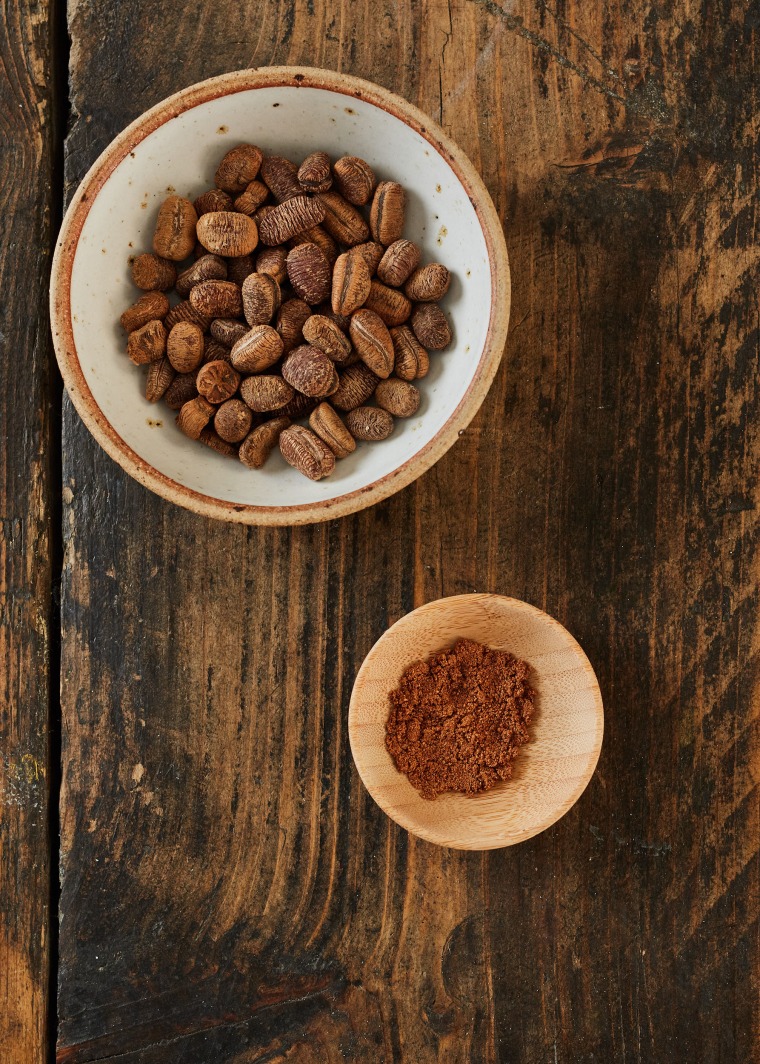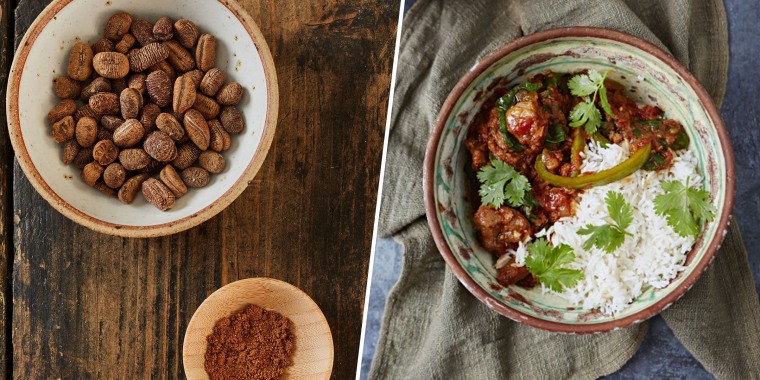If a spice could be a superhero, calabash nutmeg would be the child of Black Panther and his ex-girlfriend Storm.
Vibrant orange and red-speckled flower petals dot the trees from which calabash nutmeg grows, curling down from the plant’s branching canopy like hanging spotted orchids. Amidst the lush greenery, spherical green fruits droop from long stalks; their interiors have veiny red helmets that resemble comic hero’s costumes. Like cacao, they contain a whitish pulp that surrounds oblong seeds which, when removed, dried and ground, become the spice known as calabash nutmeg.

What is calabash nutmeg?
A cheaper alternative to its more commonly known cousin, nutmeg, calabash nutmeg is an aromatic cooking spice that complements a variety of dishes — generally in small doses — and is said to alleviate various ailments. Calabash nutmeg — aka ehuru, ehu, ariwo, awerewa, ehiri, airama, African nutmeg or Jamaican nutmeg — comes from evergreen forests of West Africa, specifically from Monodora myristica, a tropical tree of the Annonaceae (aka custard apple or soursop) family. Native to West Africa, Uganda, Kenya and Tanzania, calabash nutmeg was introduced to Jamaica and parts of the Caribbean in the 18th century during the slave trade.
The tree’s emerald, pear-sized fruits become woody and bear hundreds of seeds, which can be removed, dried and sold either ground, grated or whole. Sometimes roasted to intensify its flavor, calabash nutmeg’s warm, nutty taste has a deeper woodiness than the more common variety, ideal for use as a seasoning in savory dishes like soups and stews or sweet desserts like cake and pudding. Rich in potassium, iron and zinc, calabash nutmeg is said to have medical properties that span from lowering cholesterol to repelling insects.
What are its traditional uses and health benefits?
Aside from its function in cooking or baking as a seasoning, calabash nutmeg has an array of traditional medicinal purposes. Categorized by some as an antimicrobial and a stimulant, it has been said to help with intestinal issues, and when ground into a powder, it can serve as an antiseptic applied to irritated skin. It has demonstrated effectiveness in preventing nausea, treating eye diseases, hypertension and hemorrhoids, and has even shown promising anti-sickling effects. Potentially beneficial for folks dealing with heart conditions, calabash nutmeg, which is a source of calcium, folic acid, and vitamins C and E, may reduce the risk of cardiovascular diseases by lowering cholesterol.
While a spate of studies continue to come out on its holistic health benefits and medicinal qualities, calabash nutmeg has been used to treat a wide range of maladies by certain communities for centuries. In traditional medicine, when combined with Ashanti pepper in soup, calabash nutmeg has been used to control passive bleeding from the womb immediately after childbirth. It is also used as a remedy for relieving pain, inducing sleep and reducing fevers.
How do you cook with calabash nutmeg?
If all that wasn’t enough, calabash nutmeg also infuses its flavor into a variety of dishes — soups, salads and stews, like Nigerian pepper soup, nkwobi (spicy cow foot), isi ewu (goat meat stew) and tomato-based stews. The plant-derived spice can also be used to prepare Ehuru and Wildflower Honey Butter or Palm Nut and Calabash Nutmeg Egusi Soup. I also have a recipe for Ghanaian five-spice blend which includes calabash nutmeg and cubeb and is used in my Ghanaian Spiced Shortbread and Goat Shoko recipes.
The affordable, accessible ingredient amidst pricier, more sought-after spices is perhaps something to keep in mind when next shopping for spices. And, as with other African ingredients, a way to begin decolonizing the food and beverage industry is to source it from Black-owned businesses.



